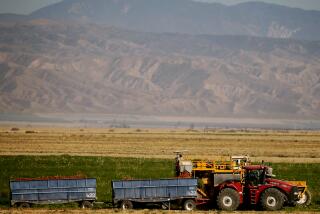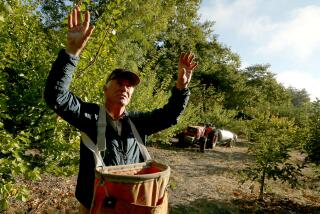THE DROUGHT : Farmers Let Trees Die as Water Costs Rise
- Share via
High in the hills above Moorpark, the drought is drinking up the water under the Leavens family ranch.
In a normal season, sprinklers would tap into three wells 550 feet below the surface to water 500 acres of citrus and avocado groves.
But in the past four years, the water level has dropped about 100 feet to the lowest level in the 67-year history of the farm, manager Link Leavens said. Pumping costs have risen about 15%.
“We thought last year was bad,” said Leavens, a veteran of 16 years of farming. But this year has been “progressively worse. . . . It’s the worst year that we collectively have experienced as a farming community.”
In an average year, cities and farmers in Ventura County remove 35,000 acre feet more water from the ground than is replaced by rainfall. But as the drought has worsened, that deficit has more than doubled, to 80,000 acre feet (an acre foot serves a family of four for a year).
While there is still an estimated 540-year supply in the Fox Canyon aquifer, the largest water basin in the county, stretching from Moorpark to the Pacific Ocean, farmers are facing mounting hardships in a county where water quality is slowly eroding and the cost of bringing it to the surface is rising, Leavens said.
The most immediate effects of the drought may be seen in the supermarket as increasing farm operating costs result in higher produce prices. And for some farmers, who are allowing avocado trees to die rather than pay more to water them, the drought has already become painful.
Despite the inconvenience and threats of water cutbacks to agriculture, most farmers have not yet been hard hit by water problems. But they are worried about what will happen if the drought continues.
“Everyone’s hoping for the best, hoping that the crisis won’t come to fruition,” said Larry Rose, who heads the California Avocado Society.
But many are doing more than hoping. They are girding for future dry years by investing in expensive water-stingy irrigation systems and planning to scale back on marginal crops, or cutting down some orchards.
More than 300,000 acres of land are devoted to agriculture in Ventura County, where 1,752 farms depend on local underground water sources to irrigate crops.
Farmers make up the largest group of water users in the county, consuming 68% of the 407,000 acre feet used each year.
Farmers such as Leavens must drill deeper and deeper to find water. But if their subterranean wells are close to the coast on the Oxnard Plain, there is another problem: too little fresh water and too much seawater.
The Fox Canyon aquifer covers a 185-square-mile area, but the continued mining of the aquifer by cities and farmers during dry years is causing the water level to drop. Seawater has swept into a 22.8-square-mile area, a zone that increases as the water level declines.
To address this problem, officials at the Groundwater Management Agency have proposed a 25% cutback in pumping until the year 2015. Farmers who use too much water could face stiff penalties under the proposal, which is now being reviewed by agency lawyers in advance of a meeting June 22 to consider adopting the measure, said John Turner, staff hydrologist for the GMA.
Elsewhere, farmers in the eastern part of the county who depend on imported water also are being forced to cut back by 10%, said Reddy Pakala, manager of the Ventura County Waterworks District No. 1. Pakala said that due to the statewide drought, the Metropolitan Water District has warned its distributors of an impending curtailment.
Cutbacks also are being ordered in the western part of the county, where a resolution by the Casitas Municipal Water District asks agricultural customers to conserve by about 20%.
If voluntary measures fail to achieve that goal, the district will be forced to impose mandatory measures next year, said Dick Barnett, engineering department manager for Casitas.
Farmers say they waste little of the water they use.
“Farmers are cutting back because there is a water shortage,” Ventura County Farm Bureau President Don Reeder said. “Everybody I’ve seen is cooperating in saving water one way or the other.”
The owner of Pro-Ag, a land management firm that operates 100 farms in Ventura County, Reeder said other farmers have spent thousands of dollars on irrigation systems to regulate water use. Some have switched to low-flow sprinklers to avoid overwatering, he said.
Others have changed crop rotation schedules or left land temporarily untilled in hopes of more rainfall later in the year, Reeder said. As an extreme measure, growers have stopped growing crops that use a lot of water.
Mike Fricke, an avocado grower in Moorpark, said he has cut down trees that bear a low-value fruit, the thin-skinned bacon avocado, and some trees that bear the higher-priced Haas avocados.
Despite those measures, the price of water has forced him to pinch pennies. He says it is unlikely he will see a return on his investment.
“This year the fruit’s not even going to pay for the water, let alone the irrigation or maintenance,” Fricke said.
Along Grimes Canyon Road and Hitch Boulevard west of Moorpark, other avocado growers have shut off the water to some orchards where imported water is so expensive that it amounts to half the costs of growing the crop, Rose said.
Leaves on trees that took decades to cultivate are turning brown because of increasing salt content in the soil from irrigation, he said.
“We haven’t had enough rain to leach it out of the soils,” Rose said.
Costs are prohibitive for some farmers to upgrade their irrigation systems, said Dave Pommer, who manages a 900-acre lemon orchard in Oxnard for the U.T.T. Development Co., which still uses an old-fashioned furrow irrigation system. Installing a new system would cost about $1,300 an acre, Pommer said, and “we might never see our money back.”
Farmers are doing more than buying new irrigation systems and cutting back on production. They have gone back to school.
Attendance at seminars on irrigation and conservation has climbed, said Lee Waddle, an irrigation specialist with the Ventura County Resource Conservation District.
During the past year and a half, a mobile irrigation laboratory operated by the district has succeeded in getting 177 farmers to volunteer to review their practices and has encouraged them to use more scientific methods of evaluating weather conditions and crops, Waddle said.
Some farmers have not been eager to face the music, Waddle said.
However, “as time goes on, I can see there’s more acceptance of the mobile lab,” he said.
If voluntary conservation measures fail, water officials said, it is because farmers have no reason to cut back while water is still available and pumping costs are still relatively low, compared to the costs of imported water.
Pumping costs range from $60 to $160 per acre foot, while farmers pay up to $325 per acre foot for imported water. Homeowners, by comparison, pay an average of twice as much as farmers for the percentage of water they use, about 22% of the entire amount used in the county.
“That’s probably what the biggest problem is, there isn’t any economic pressure” on farmers, said Frank Brommenschenkel, president of the Assn. of Water Agencies in Ventura County.
“I’m not saying ag can’t improve their efficiency any more than local homeowners can’t improve their efficiency,” Brommenschenkel said.
Some farmers say they are doing all they can to conserve water.
“If you cut down 40%, in essence you’ve lost your crop,” Pommer said.
Farmers’ greatest fear is that the current drought cycle might continue. Ventura County is in the middle of a multi-year drought that some think could last into the middle of the decade, farm adviser Bob Brendler said.
Lack of rain has not forced the Leavens farm out of business, but dwindling water supplies might force Leavens to allow the least productive fields to die.
“We’re mining a resource that’s a finite resource,” Leavens said. “We’re banking on borrowed time.”
More to Read
Sign up for Essential California
The most important California stories and recommendations in your inbox every morning.
You may occasionally receive promotional content from the Los Angeles Times.













